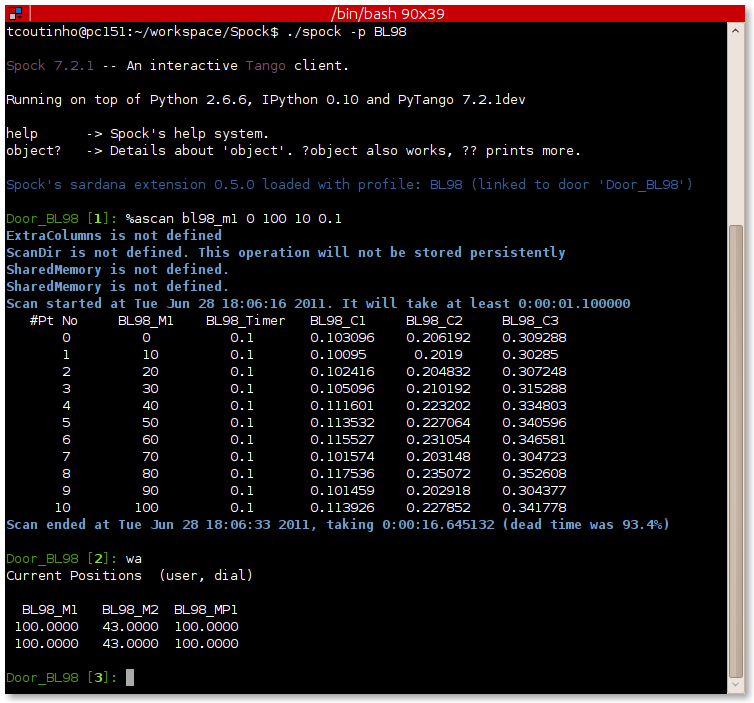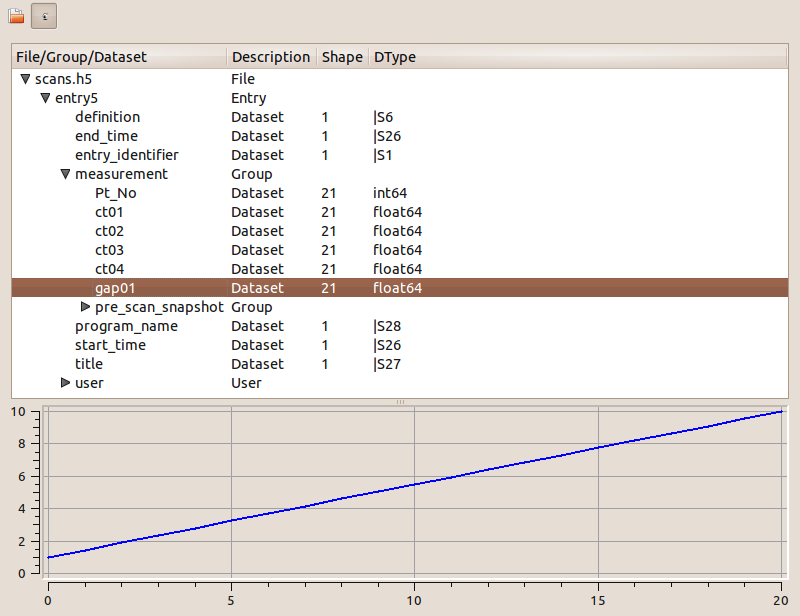Spock¶
Spock is the prefered CLI for sardana. It is based on IPython. Spock automatically loads other IPython extensions like the ones for PyTango and pylab. It as been extended in sardana to provide a customized interface for executing macros and automatic access to sardana elements.
Spock tries to mimic SPEC’s command line interface. Most SPEC commands are available from spock console.

Spock CLI in action
Starting spock from the command line¶
To start spock just type in the command line:
marge@machine02:~$ spock
This will start spock with a “default profile” for the user your are logged with. There may be many sardana servers running on your system so the first time you start spock, it will ask you to which sardana system you want to connect to by asking to which of the existing doors you want to use:
marge@machine02:~$ spock
Profile 'spockdoor' does not exist. Do you want to create one now ([y]/n)?
Available Door devices from homer:10000 :
On Sardana LAB-01:
LAB-01-D01 (running)
LAB-01-D02 (running)
On Sardana LAB-02:
LAB-02-D01
Please select a Door from the list? LAB-01-D01
Storing ipy_profile_spockdoor.py in /home/marge/.ipython... [DONE]
Note
If only one Door exists in the entire system, spock will automatically connect to that door thus avoiding the previous questions.
Afterward, spock CLI will start normally:
Spock 7.2.1 -- An interactive sardana client.
help -> Spock's help system.
object? -> Details about 'object'. ?object also works, ?? prints more.
Spock's sardana extension 1.0 loaded with profile: spockdoor (linked to door 'LAB-01-D01')
LAB-01-D01 [1]:
Starting spock with a custom profile¶
spock allows each user to start a spock session with different configurations (known in spock as profiles). All you have to do is start spock with the profile name as an option.
If you use ipython version > 0.10 you can do it using –profile option:
spock --profile=<profile name>
Example:
marge@machine02:~$ spock --profile=D1
Otherwise (ipython version 0.10) you can do it using -p option:
spock -p <profile name>
Example:
marge@machine02:~$ spock -p D1
The first time a certain profile is used you will be asked to which door you want to connect to (see previous chapter).
Spock IPython Primer¶
As mentioned before, spock console is based on IPython. Everything you can do in IPython is available in spock. The IPython documentation provides excelent tutorials, tips & tricks, cookbooks, videos, presentations and reference guide. For comodity we summarize some of the most interesting IPython chapters here:
Executing macros¶
Executing sardana macros in spock is the most useful feature of spock. It is
very simple to execute a macro: just type the macro name followed by a space
separated list of parameters (if the macro has any parameters). For example,
one of the most used macros is the
wa (stands for “where all”) that
shows all current motor positions. To execute it just type:
LAB-01-D01 [1]: wa
Current Positions (user, dial)
Energy Gap Offset
100.0000 43.0000 100.0000
100.0000 43.0000 100.0000
(user for user position (number above); dial for dial position (number below).)
A similar macro exists that only shows the desired motor positions
(wm):
LAB-01-D01 [1]: wm gap offset
Gap Offset
User
High 500.0 100.0
Current 100.0 43.0
Low 5.0 -100.0
Dial
High 500.0 100.0
Current 100.0 43.0
Low 5.0 -100.0
To get the list of all existing macros use
lsmac:
LAB-01-D01 [1]: lsdef
Name Module Brief Description
------------------- ------------- ------------------------------------------------------------
a2scan scans two-motor scan. a2scan scans two motors, as specifi[...]
a2scan scans three-motor scan . a3scan scans three motors, as sp[...]
ascan scans Do an absolute scan of the specified motor. ascan s[...]
defmeas expert Create a new measurement group
fscan scans N-dimensional scan along user defined paths. The mo[...]
lsa lists Lists all existing objects
lsm lists Lists all motors
lsmac expert Lists all macros.
mv standard Move motor(s) to the specified position(s)
mvr standard Move motor(s) relative to the current position(s)
wa standard Show all motor position.
wm standard Show the position of the specified motors.
<...>
Stopping macros¶
Some macros may take a long time to execute. To stop a macro in the middle of its execution type Control+c.
Macros that move motors or acquire data from sensors will automatically stop all motion and/or all acquisition.
Exiting spock¶
To exit spock type Control+d or exit() inside a spock console.
Getting help¶
spock not only knows all the macros the sardana server can run but it also information about each macro parameters, result and documentation. Therefore it can give you precise help on each macro. To get help about a certain macro just type the macro name directly followed by a question mark(‘?’):
LAB-01-D01 [1]: ascan?
Syntax:
ascan <motor> <start_pos> <final_pos> <nr_interv> <integ_time>
Do an absolute scan of the specified motor.
ascan scans one motor, as specified by motor. The motor starts at the
position given by start_pos and ends at the position given by final_pos.
The step size is (start_pos-final_pos)/nr_interv. The number of data points collected
will be nr_interv+1. Count time is given by time which if positive,
specifies seconds and if negative, specifies monitor counts.
Parameters:
motor : (Motor) Motor to move
start_pos : (Float) Scan start position
final_pos : (Float) Scan final position
nr_interv : (Integer) Number of scan intervals
integ_time : (Float) Integration time
Moving motors¶
A single motor may be moved using the
mv motor position macro.
Example:
LAB-01-D01 [1]: mv gap 50
will move the gap motor to 50. The prompt only comes back after the motion as finished.
Alternatively, you can have the motor position displayed on the screen as it is
moving by using the umv macro
instead. To stop the motor(s) before they have finished moving, type
Control+c.
You can use the mvr motor
relative_position macro to move a motor relative to its current position:
LAB-01-D01 [1]: mvr gap 2
will move gap by two user units.
Counting¶
You can count using the ct value
macro. Without arguments, this macro counts for one second using the active
measurement group set by the environment variable ActiveMntGrp.
Door_lab-01_1 [1]: ct 1.6
Wed Jul 11 11:47:55 2012
ct01 = 1.6
ct02 = 3.2
ct03 = 4.8
ct04 = 6.4
To see the list of available measurement groups type
lsmeas. The active measuremnt group
is marked with an asterisk (*):
Door_lab-01_1 [1]: lsmeas
Active Name Timer Experim. channels
-------- ---------- ------- -----------------------------------------------------------
* mntgrp01 ct01 ct01, ct02, ct03, ct04
mntgrp21 ct04 ct04, pcII0, pcII02
mntgrp24 ct04 ct04, pcII0
to switch active measurement groups type
senv ActiveMntGrp mg_name.
You can also create, modify and select measurement groups using the expconf command
Scanning¶
Sardana provides a catalog of different standard scan macros. Absolute-position
motor scans such as ascan,
a2scan and
a3scan move one, two or three motors
at a time. Relative-position motor scans are
dscan,
d2scan and
d3scan. The relative-position scans
all return the motors to their starting positions after the last point. Two
motors can be scanned over a grid of points using the
mesh scan.
Continuous versions exist of many of the standard scan macros (e.g.
ascanc,
d3scanc,
meshc,…). The continuous scans
differ from their standard counterparts (also known as step scans) in that
the data acquisition is done without stopping the motors. Continuous scans are
generally faster but less precise than step scans, and some details must be
considered (see Scans).
As it happens with ct, the scan
macros will also use the active measurement group to decide which experiment
channels will be involved in the operation.
Here is the output of performing an
ascan of the gap in a slit:
LAB-01-D01 [1]: ascan gap 0.9 1.1 20 1
ScanDir is not defined. This operation will not be stored persistently. Use "senv ScanDir <abs directory>" to enable it
Scan #4 started at Wed Jul 11 12:56:47 2012. It will take at least 0:00:21
#Pt No gap ct01 ct02 ct03
0 0.9 1 4604 8939
1 0.91 1 5822 8820
2 0.92 1 7254 9544
3 0.93 1 9254 8789
4 0.94 1 11265 8804
5 0.95 1 13583 8909
6 0.96 1 15938 8821
7 0.97 1 18076 9110
8 0.98 1 19638 8839
9 0.99 1 20825 8950
10 1 1 21135 8917
11 1.01 1 20765 9013
12 1.02 1 19687 9135
13 1.03 1 18034 8836
14 1.04 1 15876 8901
15 1.05 1 13576 8933
16 1.06 1 11328 9022
17 1.07 1 9244 9205
18 1.08 1 7348 8957
19 1.09 1 5738 8801
20 1.1 1 4575 8975
Scan #4 ended at Wed Jul 11 12:57:18 2012, taking 0:00:31.656980 (dead time was 33.7%)
Scan storage¶
As you can see, by default, the scan is not recorded into any file. To store your scans in a file, you must set the environment variables ScanDir and ScanFile:
LAB-01-D01 [1]: senv ScanDir /tmp
ScanDir = /tmp
LAB-01-D01 [2]: senv ScanFile scans.h5
ScanFile = scans.h5
Sardana will activate a proper recorder to store the scans persistently (currently, .h5 will store in NeXus format. All other extensions are interpreted as SPEC format).
You can also store in multiples files by assigning the ScanFile with a list of files:
LAB-01-D01 [2]: senv ScanFile "['scans.h5', 'scans.dat']"
ScanFile = ['scans.h5', 'scans.dat']
Viewing scan data¶
Sardana provides a scan data viewer for scans which were stored in a NeXus
file. Without arguments, showscan
will show you the result of the last scan in a GUI:
showscan scan_number will display
data for the given scan number.
The history of scans is available through the
scanhist macro:
LAB-01-D01 [1]: scanhist
# Title Start time End time Stored
--- ------------------------------- --------------------- --------------------- -------------
1 dscan mot01 20.0 30.0 10 0.1 2012-07-03 10:35:30 2012-07-03 10:35:30 Not stored!
3 dscan mot01 20.0 30.0 10 0.1 2012-07-03 10:36:38 2012-07-03 10:36:43 Not stored!
4 ascan gap01 10.0 100.0 20 1.0 12:56:47 12:57:18 Not stored!
5 ascan gap01 1.0 10.0 20 0.1 13:19:05 13:19:13 scans.h5
Accessing macro data¶
The command macrodata allows to retrieve the data of the last macro run in spock.
If this macro does not provide any data an error message is thrown.
Example accesing scan data:
Door_1 [9]: ascan mot17 1 10 2 1
ScanDir is not defined. This operation will not be stored persistently. Use "expconf" (or "senv ScanDir <abs directory>") to enable it
Scan #2 started at Tue Feb 13 11:16:18 2018. It will take at least 0:00:05.048528
0 1 1 3 4 0.865325
1 5.5 1 3 4 2.51148
2 10 1 3 4 4.16662
Scan #2 ended at Tue Feb 13 11:16:24 2018, taking 0:00:05.201949. Dead time 42.3% (motion dead time 40.5%)
#Pt No mot17 ct17 ct19 ct20 dt
Door_1 [10]: r = %macrodata
Door_1 [11]: r[0].data.keys()
Result [11]:
['point_nb',
'timestamp',
'mot17',
'haso111n:10000/expchan/ctctrl05/4',
'haso111n:10000/expchan/ctctrl05/1',
'haso111n:10000/expchan/ctctrl05/3']
Door_1 [12]: r[0].data['point_nb']
Result [12]: 0
Door_1 [13]: r[0].data['mot17']
Result [13]: 1.0
Door_1 [16]: r[0].data['haso111n:10000/expchan/ctctrl05/1']
Result [16]: 1.0
Editing macros¶
The command edmac allows to edit the macros
directly from spock. See Writing macros section.
Debugging problems¶
Spock provides some commands that help to debug or recognize the errors in case a macro fails when being executed.
wwwprints the error message from the last macro executiondebugused withonas parameter activates the print out of the debug messages during macro execution. Set it tooffto deactivate it.post_mortemprints the current logger messages. If no argument is specified it reads thedebugstream. Valid values areoutput,critical,error,warning,info,debugandresult.
Using spock as a Python console¶
You can write any Python code inside a spock console since spock uses IPython as a command line interpreter. For example, the following will work inside a spock console:
LAB-01-D01 [1]: def f():
...: print("Hello, World!")
...:
...:
LAB-01-D01 [2]: f()
Hello, World!
Using spock as a Tango console¶
As metioned in the beggining of this chapter, the sardana spock automatically
activates the PyTango ‘s ipython console extension. Therefore all Tango
features are automatically available on the sardana spock console. For example,
creating a DeviceProxy will work inside the sardana spock
console:
LAB-01-D01 [1]: tgtest = PyTango.DeviceProxy("sys/tg_test/1")
LAB-01-D01 [2]: print( tgtest.state() )
RUNNING
Footnotes
| [1] | The PyTango ipython documentation can be found here: ITango |
